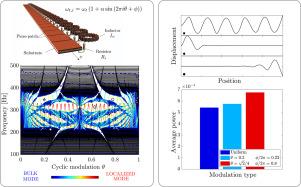Topological modes, vibration attenuation, and energy harvesting in electromechanical metastructures
IF 7.1
1区 工程技术
Q1 ENGINEERING, MECHANICAL
International Journal of Mechanical Sciences
Pub Date : 2024-10-01
DOI:10.1016/j.ijmecsci.2024.109763
引用次数: 0
Abstract
The dynamics of topological boundary modes in both periodic and quasi-periodic electromechanical metastructures is investigated, with a focus on their applications to energy harvesting and vibration reduction. The metastructure analyzed in this study is based on a shunted array of piezoelectric patches, with electrical parameters modulated according to the 1D Aubry–André–Harper model. As a result of this modulation, a fractal spectrum is generated near the central frequency of the resonators, a hallmark of nontrivial topology that enables the emergence of digitally controllable edge states and ensuing localization phenomena at subwavelength frequencies. In this framework, a detailed analysis of the metastructure spectral characteristics is conducted to investigate the influence of the modulation parameters on mode localization, both at the boundaries and within the interior of the beam. Such localization effects are then studied in relation to the energy harvesting, attenuation, and wave transport capabilities of the system. These functionalities point toward the realization of self-powered structures with low frequency and digitally controllable vibration attenuation capabilities, and are considered of significant technological interest in applications involving elastic waves and vibrations, where the ability to precisely control and harness these phenomena could lead to innovative solutions in energy-efficient and adaptive systems.

机电转移结构中的拓扑模式、振动衰减和能量收集
本研究探讨了周期性和准周期性机电转移结构中拓扑边界模式的动力学,重点是其在能量收集和减震方面的应用。本研究分析的元结构基于分流压电贴片阵列,其电气参数根据一维 Aubry-André-Harper 模型进行调制。这种调制的结果是,在谐振器的中心频率附近产生了分形频谱,这是非琐碎拓扑结构的一个标志,它使数字可控边缘状态和随之而来的亚波长频率局部化现象得以出现。在此框架下,我们对元结构的光谱特性进行了详细分析,以研究调制参数对光束边界和内部模式局部化的影响。然后,结合系统的能量收集、衰减和波传输能力,对这种定位效应进行研究。这些功能指向实现具有低频和数字可控振动衰减能力的自供电结构,并被认为在涉及弹性波和振动的应用中具有重要的技术意义,在这些应用中,精确控制和利用这些现象的能力可为高能效和自适应系统带来创新解决方案。
本文章由计算机程序翻译,如有差异,请以英文原文为准。
求助全文
约1分钟内获得全文
求助全文
来源期刊

International Journal of Mechanical Sciences
工程技术-工程:机械
CiteScore
12.80
自引率
17.80%
发文量
769
审稿时长
19 days
期刊介绍:
The International Journal of Mechanical Sciences (IJMS) serves as a global platform for the publication and dissemination of original research that contributes to a deeper scientific understanding of the fundamental disciplines within mechanical, civil, and material engineering.
The primary focus of IJMS is to showcase innovative and ground-breaking work that utilizes analytical and computational modeling techniques, such as Finite Element Method (FEM), Boundary Element Method (BEM), and mesh-free methods, among others. These modeling methods are applied to diverse fields including rigid-body mechanics (e.g., dynamics, vibration, stability), structural mechanics, metal forming, advanced materials (e.g., metals, composites, cellular, smart) behavior and applications, impact mechanics, strain localization, and other nonlinear effects (e.g., large deflections, plasticity, fracture).
Additionally, IJMS covers the realms of fluid mechanics (both external and internal flows), tribology, thermodynamics, and materials processing. These subjects collectively form the core of the journal's content.
In summary, IJMS provides a prestigious platform for researchers to present their original contributions, shedding light on analytical and computational modeling methods in various areas of mechanical engineering, as well as exploring the behavior and application of advanced materials, fluid mechanics, thermodynamics, and materials processing.
 求助内容:
求助内容: 应助结果提醒方式:
应助结果提醒方式:


